MSI Stealth A16 AI+ review: A jack-of-all-trades

 Image: IDG / Matthew Smith
Image: IDG / Matthew SmithAt a glance
Expert’s Rating
Pros
Chassis feels durableGreat wired and wireless connectivityWell-rounded CPU and GPU performanceLengthy battery life
Cons
Awkward keyboard and touchpad layoutMedicore IPS displayGPU performance slightly behind competitors
Our Verdict
The MSI Stealth A16 AI+ is a jack-of-all-trades that tries to deliver strong CPU and GPU performance in a thin chassis yet also provide lengthy battery life. It mostly succeeds, though its mediocre display is a bummer.
Price When Reviewed
This value will show the geolocated pricing text for product undefined
Best Pricing Today
Shoppers looking for a 16-inch laptop have no shortage of choice. The MSI Stealth A16 AI+ is yet another option in this packed arena and, as its name implies, it doesn’t stand out at first glance. However, the MSI Stealth A16 AI+ is worth your attention if you need one laptop that can handle a bit of everything.
Further reading: Best laptops 2024: Premium, budget, gaming, 2-in-1s, and more
MSI Stealth A16 AI+: Specs and features
The MSI Stealth A16 AI+ pairs an AMD Ryzen AI 9 365 processor with an Nvidia RTX 4070 mobile GPU. This is a popular choice for laptops looking to deliver strong performance in a relatively thin and light chassis.
Model number: A3XVEGCPU: AMD Ryzen AI 9 365Memory: 32GB LPDDR5x-7500Graphics/GPU: Nvidia RTX 4070 mobileNPU: Integrated NPU (Up to 50 TOPs)Display: 2560×1600 16:10 IPS 240HzStorage: 1TB PCIe 4.0 NVMe M.2 solid state storageWebcam: 1080p 30fps camera with IR 3D camera for Windows Hello, physical privacy shutterConnectivity: 1x Thunderbolt 4 / USB-C with DisplayPort, USB Power Delivery, 2x USB-A 3.2 Gen 2, 1x HDMI 2.1, 1x 2.5GbE LAN EthernetNetworking: Wi-Fi 7, Bluetooth 5.4Biometrics: Windows Hello facial recognitionBattery capacity: 99.9 watt-hoursDimensions: 14.01 x 10.22 x 0.79 inchesWeight: 4.63 poundsMSRP: $1,999.99 MSRP
MSI provides a wide range of physical connectivity that includes an Ethernet port (a feature many laptops no longer offer). The Stealth A16 AI+ also has a large battery and supports biometric login through both a fingerprint reader and facial recognition. Alone, none of these features are unusual, but it’s great to see them together in a laptop priced at $2,000.
The MSI Stealth A16 AI+ is a well-rounded laptop that’s best for people who need one machine capable of handling many tasks.
MSI Stealth A16 AI+: Design and build quality
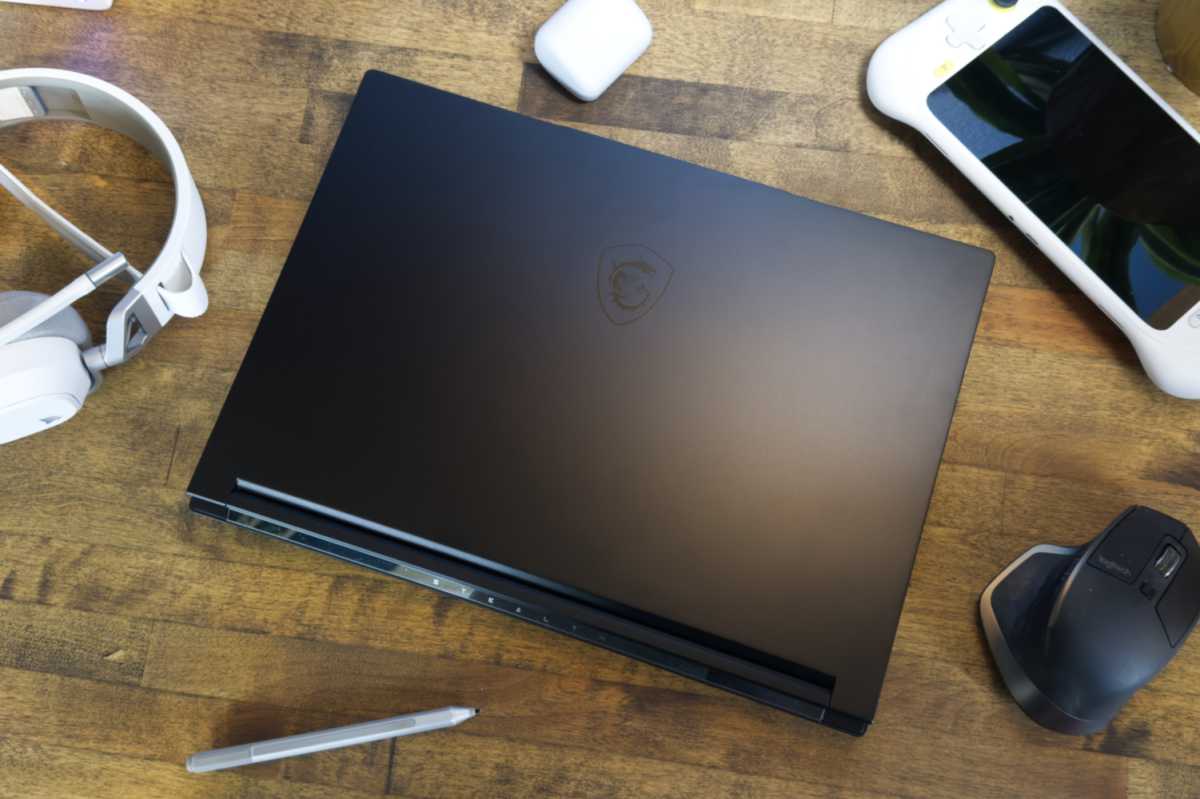
IDG / Matthew Smith
The MSI Stealth A16 AI+ looks subtle at a glance. Like most laptops, it’s constructed from aluminum and plastic panels that together strike a handsome, yet unassuming, pose. The laptop’s black colorway, thin (though not super thin) design, and 16-inch display panel make it easy to mistake the laptop for competitors. Acer’s Swift X series and Lenovo’s thinnest Legion laptops look similar, especially when closed.
Still, MSI nails the details. The aluminum panels that span the interior and exterior have an attractive metallic luster that catches ambient light, and a subtle glossy accent strip on the laptop’s rear provides a touch of luxury. It’s a tightly bolted laptop, too. I noticed only the slightest display flex when opening the laptop, and the chassis felt robust when I picked it up from one corner.
The Stealth A16 AI+ is portable, but not any more so than the competition. It measures roughly eight-tenths of an inch thick, 14 inches wide, and weighs about 4.6 pounds. That’s certainly light enough that it won’t feel burdensome in a backpack, but there’s a long list of competitors, from the Dell XPS 16 to the Asus ProArt P16, that offer similar or better portability.
MSI Stealth A16 AI+: Keyboard, trackpad
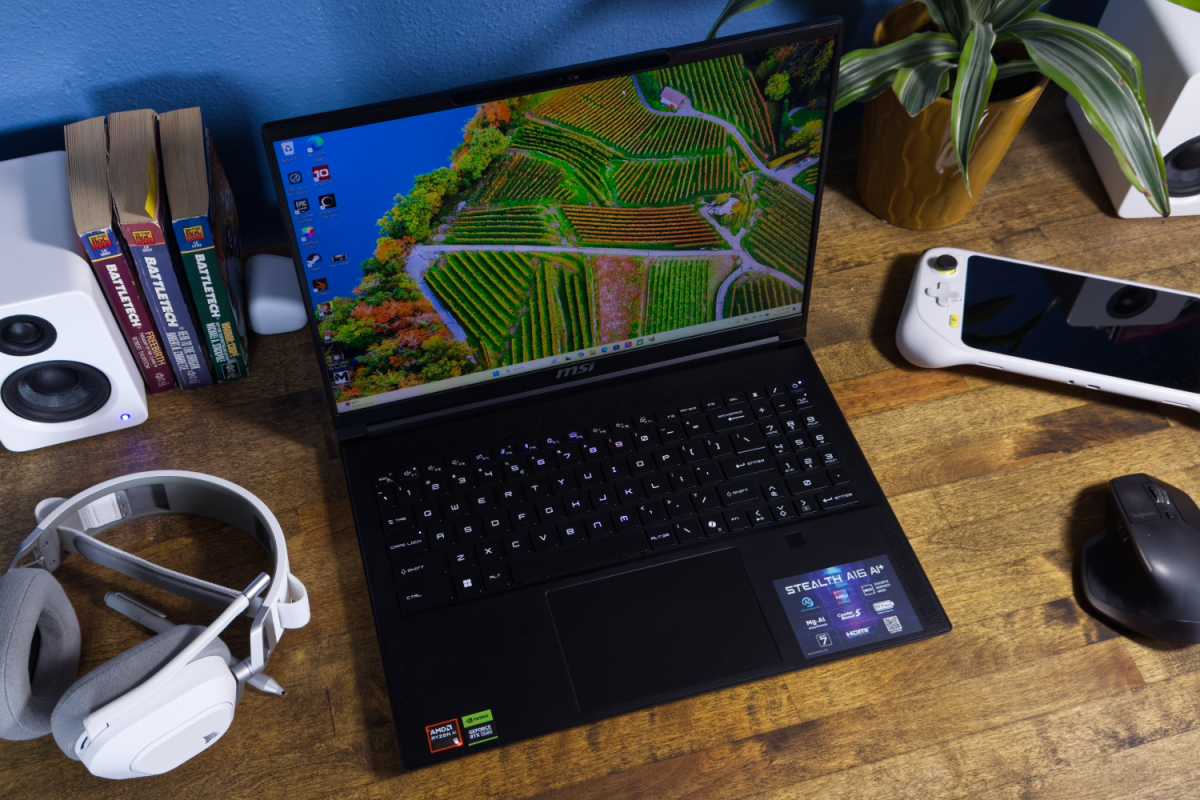
IDG / Matthew Smith
MSI packs a keyboard in numpad in the Stealth A16 AI+ which is a polarizing choice. There’s barely enough space for the numpad, which means the keys are extremely small. The numpad shifts the keyboard towards the left, placing it offset from the touchpad, which remains centered. I got used to it, but I would have preferred a center-aligned keyboard without a numpad.
Awkward layout aside, the keyboard has good key travel and a pleasant typing feel. Each key activates with a subtle but noticeable tactile snap. The keyboard has SteelSeries-branded customizable RGB-LED backlighting, as well, which is managed through SteelSeries’ software. This is a good decision, as SteelSeries’ software is attractive and intuitive.
The Stealth A16 AI+ has an adequate touchpad that measures about five inches wide and three inches deep. Most competing laptops have a touchpad of similar size, but it’s not as large as class leaders like the Razer Blade 16 and Microsoft Surface Laptop 15. There’s still enough room to use Windows’ multi-touch gestures, though, and the touchpad’s surface felt smooth and responsive
MSI Stealth A16 AI+: Display, audio
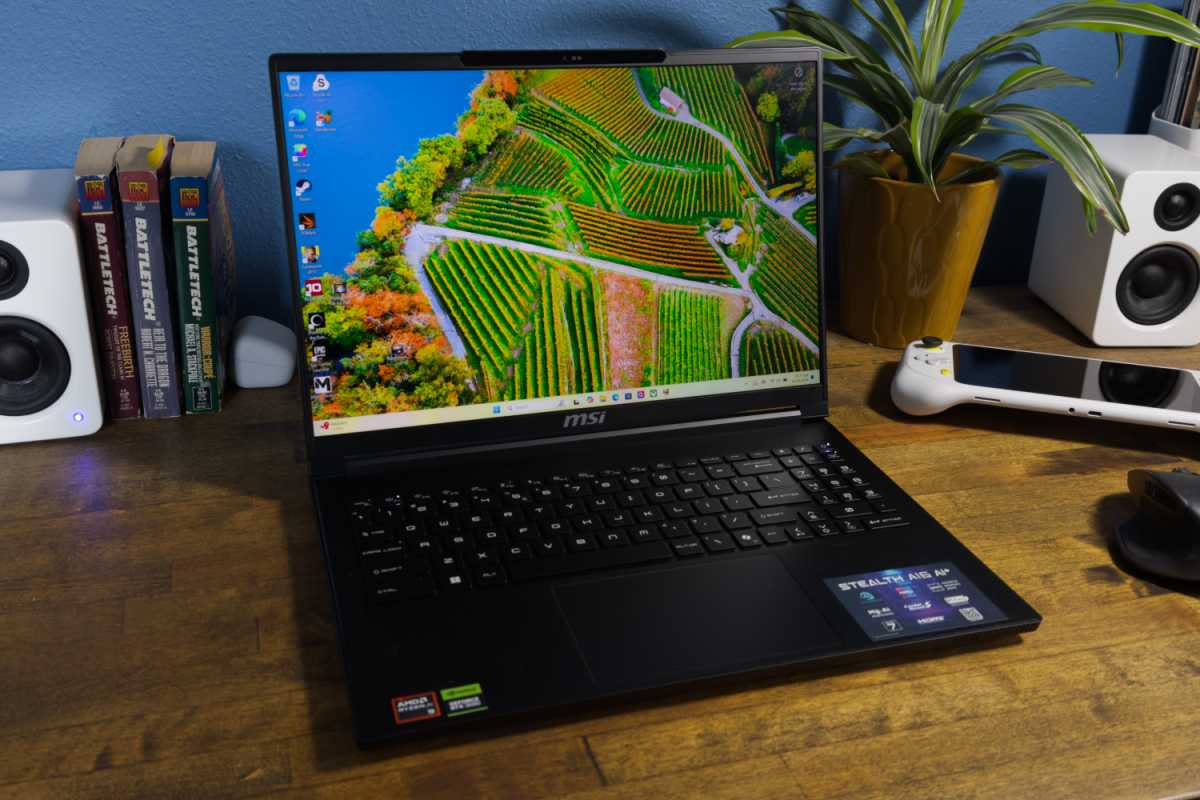
IDG / Matthew Smith
There’s a lot to like about the MSI Stealth A16 AI+, but the display is a weakness. The laptop arrived with a 16-inch 2560×1600 resolution display in a 16:10 aspect ratio. It also has a maximum refresh rate of up to 240Hz refresh rate and provides clear, crisp motion in fast-paced games (though Adaptive Sync is unfortunately absent).
That all sounds fine, but the display relies on outdated IPS panel technology.
Calling it “outdated” is a bit controversial, I’m sure, but I’m going to go ahead and say it: I think that IPS is outdated, at least on a laptop price above $1,000. This is mostly due to the poor contrast ratio of IPS panels, which lags far behind OLED and Mini-LED alternatives. A low contrast ratio translates to a dull, flat image.
It’s not just about contrast, though. The Stealth A16AI+ isn’t especially bright, with a maximum SDR brightness of 364 nits. It has a wide color gamut, too, and can handle 98 percent of the popular DCI-P3 color gamut. However, it covers only 87 percent of the wider AdobeRGB gamut. Most OLED displays crack 90 percent.
None of this is to say the MSI Stealth A16 AI+ has a terrible display. It looks ok. Good, even, when displaying bright and colorful content. Still, many competitors now use OLED displays, and they’re just…better.
Audio quality, on the other hand, is a strength. The Stealth A16 AI+ has upwards-firing speakers in the palm rest which provide strong, clear audio with good range and a hint of bass. They’re a bit lacking in volume, which places them behind class leaders like the Lenovo Yoga 9i Pro, but I think most people will be pleased by the MSI’s audio performance.
MSI Stealth A16 AI+: Webcam, microphone, biometrics
The MSI Stealth A16 AI+ has a typical camera and microphone setup for a high-end Windows laptop. A 1080p webcam with HDR is paired with a dual microphone array. Both are passable. The webcam provides an acceptable image, but can get very grainy in low light, while the microphone captures audio at good volume but suffers the hollow, distant quality common to laptop microphones.
Biometric login is available through Windows Hello for both fingerprint and facial recognition. The fingerprint reader is located to the left of the touchpad, which I think is preferable to placing it on the power button (you don’t have to worry you’ll accidentally put the laptop to sleep). I prefer facial recognition, though, because it activates when the display lid is opened and provides touchless login.
MSI Stealth A16 AI+: Connectivity
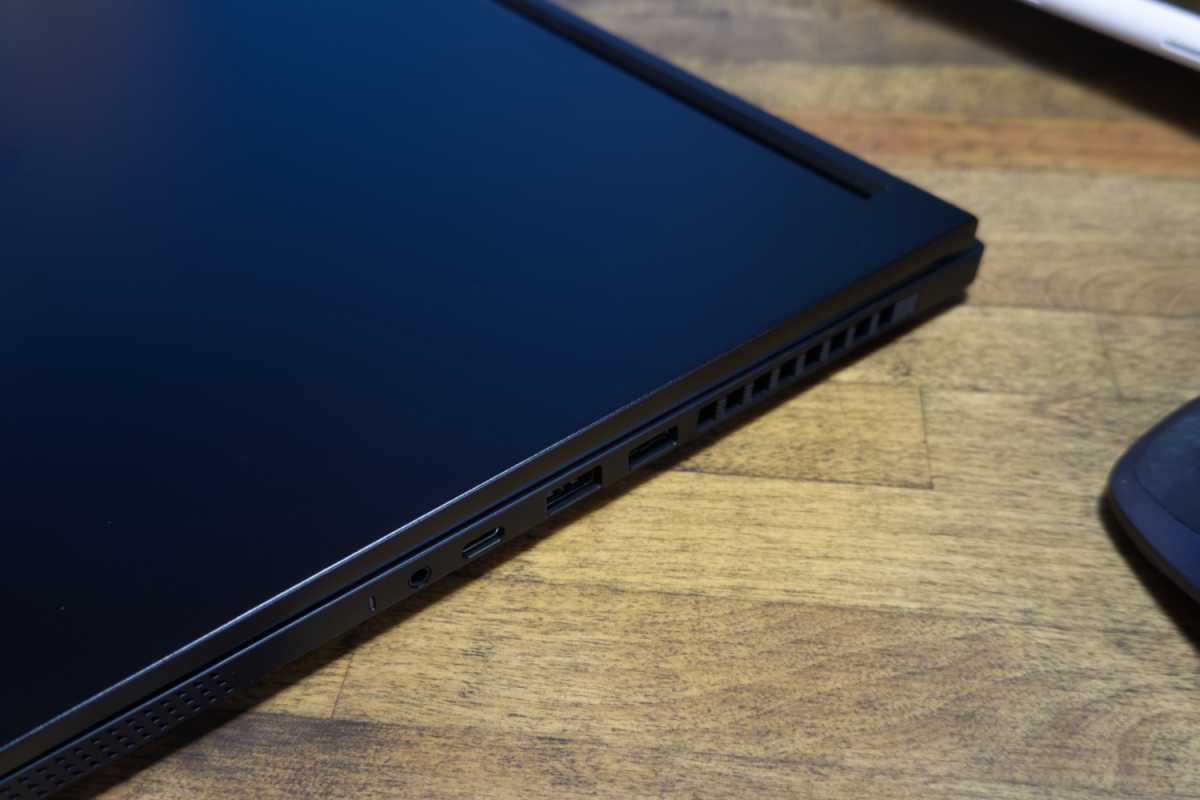
IDG / Matthew Smith
Like ports? You’ll like the MSI Stealth A16 AI+. It has one Thunderbolt 4 port with USB-C 4, DisplayPort, and USB Power Delivery (the laptop’s power brick does not use USB-C, however). These are joined by two USB-A 3.2 Gen 2 ports, one HDMI 2.1, and 2.5GbE LAN Ethernet.
That’s a good array of ports for a modern laptop. There’s ample connectivity for new Thunderbolt 4 and USB-C devices, yet still plenty of options for connecting to older wired peripherals, a television, or a router. This works to MSI’s advantage, as many competitors lack HDMI, and a majority lack wired Ethernet.
Wireless connectivity is excellent, too, as the laptop supports Wi-Fi 7 and Bluetooth 5.4. These are the latest versions of each standard.
MSI Stealth A16 AI+: Performance
The MSI Stealth A16 AI+ is packing hardware that’s more powerful than its slim form factor lets on. AMD’s Ryzen AI 9 365 delivers CPU grunt, while Nvidia’s RTX 4070 mobile delivers on graphics.

IDG / Matthew Smith
PCMark 10, a holistic synthetic benchmark that relies in part on CPU, GPU, and memory performance, reported a favorable score of 7,718 on the MSI Stealth A16 AI+.
This is similar to most competitive laptops with AMD Ryzen AI 9 or Intel Core Ultra 9 chips, but it’s the second best result among the laptops chosen for comparison. That puts the MSI Stealth A16 AI+ off to a great start.
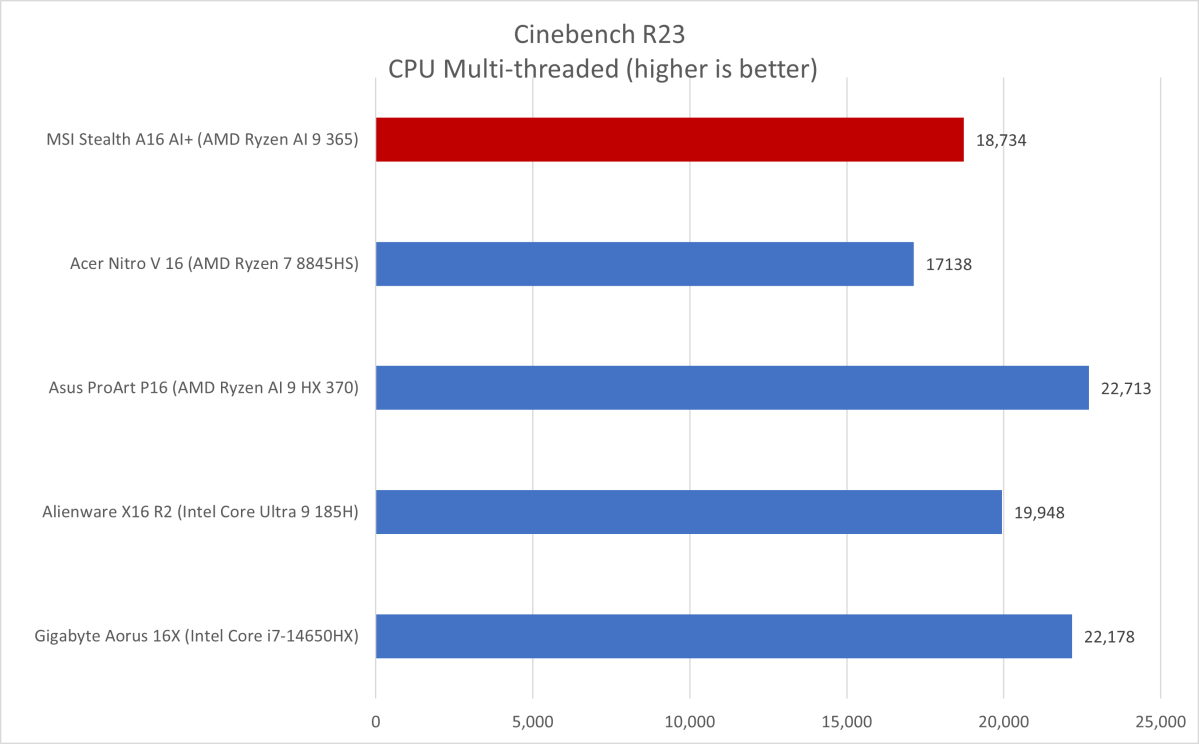
IDG / Matthew Smith
Next up is Cinebench R23, a heavily multithreaded CPU tests with a short duration. Here, the MSI Stealth A16 AI+ posts a decent but less respectable result. It’s not slow, but it’s beaten by three alternatives with higher-tier examples of AMD and Intel hardware. This suggests that the Stealth A16 AI+, though speedy overall, isn’t the best choice if you’re running software that leans heavily on the CPU yet gains little or nothing from the GPU.

IDG / Matthew Smith
Handbrake is another heavily multithreaded CPU benchmark, but with a longer duration (between 10 and 30 minutes, usually). The MSI Stealth A16 AI+ did better than expected in this test, as it managed eek out a win over the Asus ProArt P16. This is a good result, and indicates the MSI is a good choice for longer-duration CPU workloads.

IDG / Matthew Smith
In 3DMark Time Spy, our first graphics test, the MSI Stealth A16 AI+ posted a score of 10,422. That’s typical for a 16-inch laptop that has Nvidia graphics in a reasonably portable chassis, and it effectively ties the Asus ProArt P16. Laptops like the Gigabyte Aorus 16X can achieve better results, even with the same Nvidia RTX 4070 GPU inside. But the Gigabyte is thicker, at up to once inch thick, and weighs a pound more.
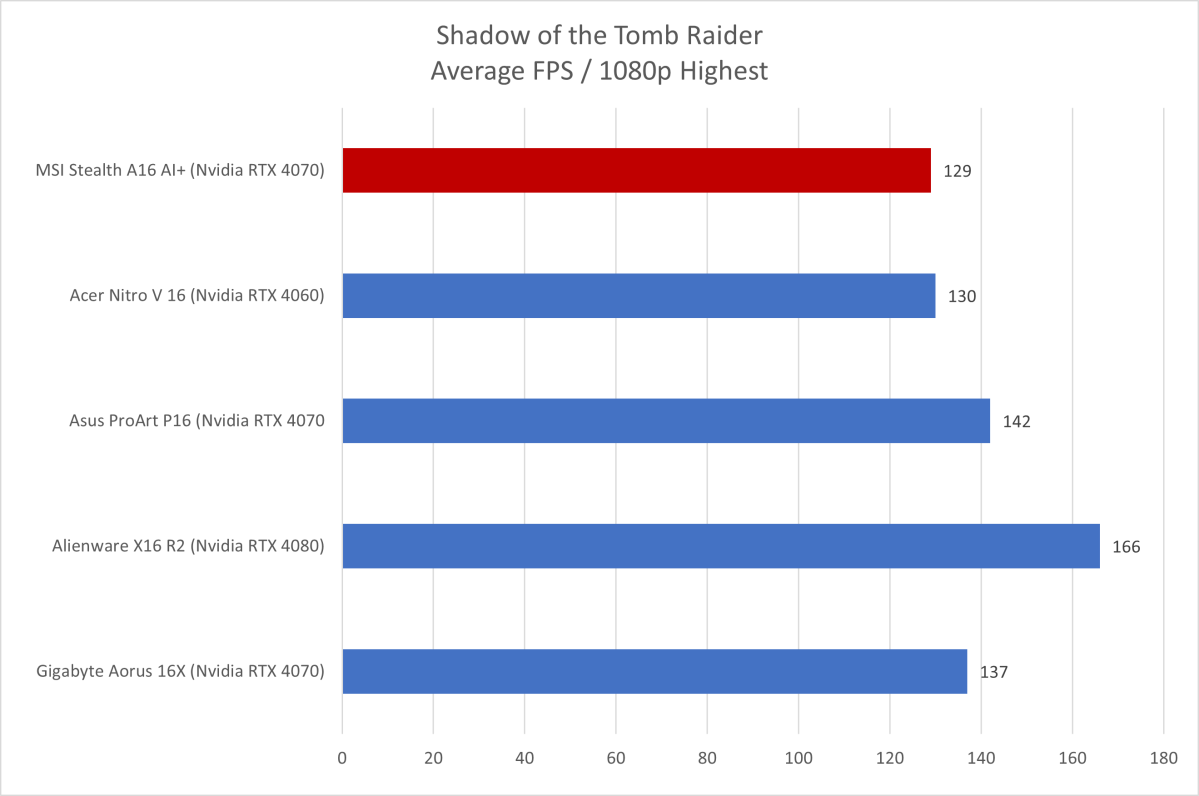
IDG / Matthew Smith
Shadow of the Tomb Raider is now six years old, believe it or not, but it remains a good example of what players can expect from modestly demanding games released in the PlayStation 4 / Xbox One console generation. The MSI Stealth A16 AI+ is no slouch, as it delivered an average frame rate of 129 frames per second. It is a step behind some competitors, however.

IDG / Matthew Smith
It’s a similar story in Metro: Exodus, an older but still extremely demanding game that, at its highest detail settings, can really stress Nvidia’s RTX 4070. The MSI Stealth A16 AI+ averaged 43 frames per second, which is respectable, but notably behind the Asus ProArt P16’s score average of 50 frames per second.
I wrapped up the graphics tests with Cyberpunk 2077, a notoriously demanding title. The MSI Stealth AI 16 AI+ averaged 73 FPS at 1080p resolution and Ultra detail. It also delivered a barely-playable 31 FPS at 1080p resolution with the OverDrive ray-traced preset. Both numbers are solid figures. Compared to the Asus ProArt P16, the MSI tied at Ultra detail and scored a victory in the OverDrive ray-traced mode.
The MSI Stealth A16 AI+ is a strong but unsurprising performer. It delivered a great result in PCMark 10 and good results across both CPU and GPU-specific benchmarks. With that said, though, it doesn’t leap out in any particular area and often lands behind the comparable Asus ProArt P16. In fairness to the MSI, however, the ProArt P16 is $300 more expensive.
MSI Stealth A16 AI+: Battery life
The MSI Stealth A16 AI+ claims to have a 99.9 watt-hour battery. I say “claims” because that is not what Windows reported. It instead placed the battery’s capacity a bit below 97 watt-hours. Either way, it’s close to the largest battery available in a modern laptop.
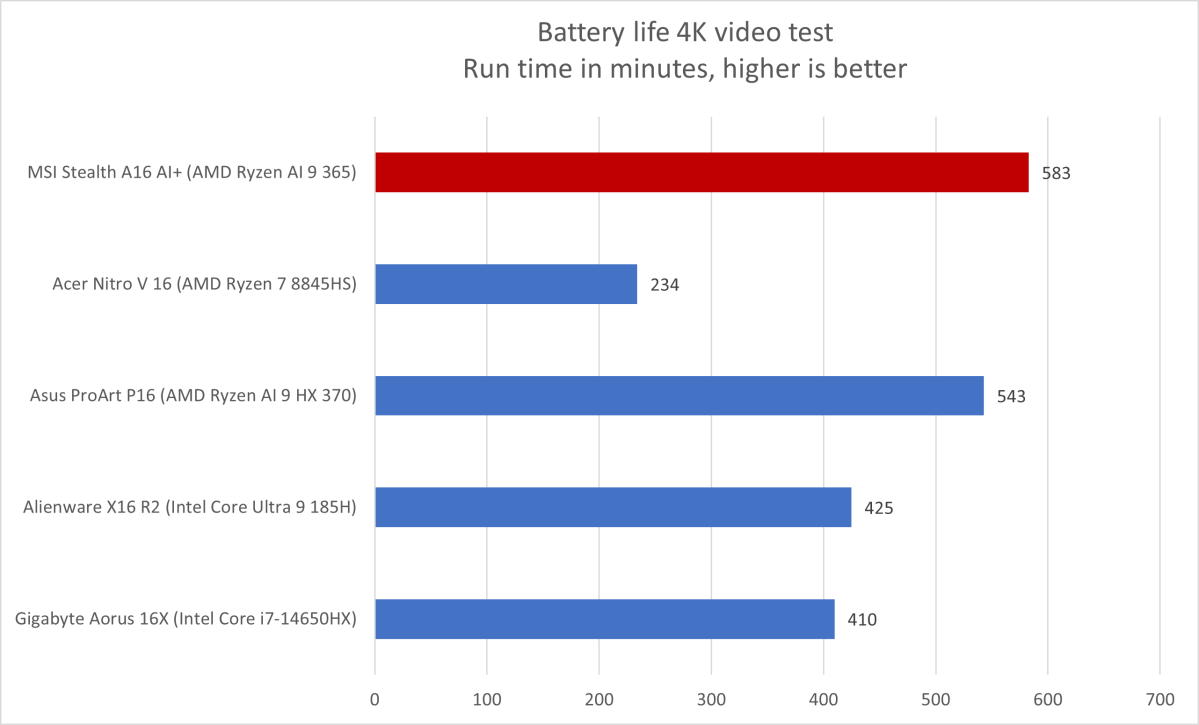
IDG / Matthew Smith
And it pays off.
The MSI Stealth A16 AI+ achieved almost 10 hours of battery life. That’s a great result for a laptop with a powerful mobile GPU. Though it’s still far behind the 20 hours or more that is possible with the longest-lasting portable laptops, the MSI Stealth A16 AI+ is in a different performance category.
MSI Stealth A16 AI+: Conclusion
The MSI Stealth A16 AI+ is a well-rounded laptop that’s best for people who need one machine capable of handling many tasks. It’s quick enough to handle demanding content creation, has a GPU that can play modern games at respectable resolutions and detail settings (and accelerate some productivity tasks), and has battery life long enough to make the laptop a good travel companion.
This isn’t the best laptop for any single job. Some alternatives have better battery life, stronger performance, or a superior display. But if you need a laptop that can handle a bit of everything, the Stealth A16 AI+ fits the bill. And, speaking of bills, it’s not especially expensive; the base MSRP of $1999.99 compares well to more luxurious alternatives like the Dell XPS 16, Asus ProArt P16, and Razer Blade 16.
Author: Matthew S. Smith
Matthew S. Smith is a freelance technology journalist with 15 years of experience reviewing consumer electronics. In addition to PCWorld, his work can be found on Wired, Ars Technica, Digital Trends, Reviewed, IGN, and Lifewire. Matthew also covers AI and the metaverse for IEEE Spectrum and runs Computer Gaming Yesterday, a YouTube channel devoted to PC gaming history.
Recent stories by Matthew S. Smith:
Lenovo Yoga Slim 7i Aura Edition review: Lunar Lake does it allAcer TravelMate P4 Spin 14 review: A solid pick for professionalsMSI Stealth 18 AI Studio review: A big laptop with a big price tag






